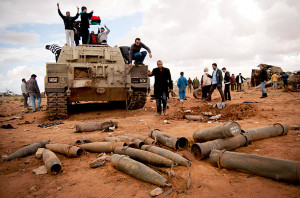
If we talk about the external effects of the “change”, we can mention an ad that appeared recently in Libya about the start of filming of a major television series entitled “Dragunov”. The poster shows a rebel with a Soviet Dragunov Sniper Rifle on his back. This serial, according to its creators, is hot on the trail of the film entitled the “February 17 Revolution”, the so called uprising against Gaddafi, which began three years ago and led to his overthrow.
The war, with a military intervention of NATO, destroyed the vertical authoritarian rule of the former government. This rule, from top to bottom, was the main backbone of statehood and stability in this vast country, almost three times the size of Ukraine, and a population of five million people.
The resulting power vacuum was filled by hundreds of large and small well-armed militias, with a very vague idea about the future of the country and its development. The integration of these groups, by the new authorities, into the army and law enforcement forces has been dragging for many reasons.
The force uniting these rebels – the hatred of former leader Gaddafi – has dissipated after their victory. Neither a general charismatic figure, nor any life-giving ideas have appeared to rally the militants. Tribal and regional particularism and ambitions, kept under control by the former regime, have been released.
The presence of weapons with no owners (at least 4 million units) has created an explosive atmosphere when it comes to resolving disputes and disagreements. Since December 2011, Libya is reeling from excesses of tribal conflicts. Most of these “hot spots” are in the south of the country. In January 2014, a two-week war between Tuba tribes and Avlyad Suleyman in Sebkha in the middle of the Sahara, took the lives of 88 people.
Construction of a new vertical power structure is creaking along. Components borrowed from the political superstructure, such as the interim parliament elected in July 2012, and a multiparty system, etc. are not based on a mature and robust foundation of the local society.
Over the last few years, it has become commonplace that the interim parliament and ministries are seized by armed groups coming from various regions. The actions of these groups, tied to tribal, clan, or land interests, are strengthened with the threads of Islamism.
In total, 120 Libyans: politicians, journalists, human rights activists, have fallen victim to military murders and assassinations, bombings and suicide operations in 2013. Most of these acts occurred in the city of Benghazi – the cradle of the uprising and February 17 Revolution.
Security disorders plague the central government as well, paralyzing the country’s economy and public administration. According to the Libyan Minister of Oil and Gas, Abdulbari Al Arusi, oil production in early 2014 amounted to 650,000 barrels per day, i.e., 40% of the pre-revolutionary level of 1.5 million barrels.
The reason for the drop – increased illegal actions of ex-militants in the east of the country, which today are seeking large shares from oil exports, the main wealth of the country. To this end, since last summer, they have blocked the work of a number of terminals used for export of the black gold.
The government, without stopping negotiations with the strikers, threatens to use force, up to the bombing of oil tankers, if they try to bring in illegal oil.
What is happening here is the process of restructuring of the ruling elite, after the departure of Gaddafi. Forces seeking to get their share of the oil wealth have joined in this struggle, working through a network of influential intermediaries.
By many indicators: oil extraction, vulnerability to various forces, the safety for both citizens and foreigners in Libya has deteriorated to pre-revolutionary times. Currents of violence in this country have flowed over its borders, to nearby geopolitical space, and contributed to the crisis in Mali.
Time will tell whether the current government will be able to cope with the destructive trends emanating from different groups, or will these take on a systemic in nature, thus condemning Libya to drift unto a “failed state”.
However, as can be seen, such a fragmented Libya, with large energy reserves and foreign currency reserves (at the end of 2012, these were estimated at $124 billion) is desirable for some countries, because it is makes it easier for them to dictate their terms.
The more the current state of instability and the “rule of man with a gun” continue, the greater the Libyan precedent is regarded with apprehension in countries of the region, which are trying to protect their sovereignty against external disturbances.
This, above all, applies to Syria. A pressure campaign has been implemented against this country, including through the channels of humanitarian assistance and psychological warfare, according to the canons of the Libyan scenario after February 2011, in order to intervene in the internal conflict in the country.
Yuri Zinin, Senior Researcher at MGIMO, exclusively for the online magazine “New Eastern Outlook”.
